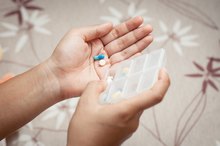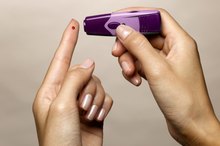What Does a Diabetic Seizure Look Like?
Managing diabetes effectively requires knowledge of the condition and the steps necessary to avoid complications. Blood glucose levels that are too high or too low for prolonged periods have detrimental effects on overall health and can lead to death. A diabetic seizure is a serious complication of this disease. Patients and caregivers must know how to avoid seizures and to recognize their signs so that proper immediate assistance is provided.
Identification
According to the American Diabetes Association, a diabetic seizure can occur when you become hypoglycemic, which means blood sugar levels have dropped too low 1. This happens if you take too much insulin, exercise vigorously without eating properly, skip meals, drink too much alcohol or have a metabolic disease. It can also occur as a reaction to medications, such as heart medicines and those that cause the pancreas to release more insulin. Hyperglycemia, or levels of blood sugar that are too high, can also lead to a diabetic seizure.
- According to the American Diabetes Association, a diabetic seizure can occur when you become hypoglycemic, which means blood sugar levels have dropped too low 1.
Initial Signs and Symptoms of a Diabetic Seizure
Signs & Symptoms Hypoglycemia & Hyperglycemia
Learn More
Initial symptoms of a diabetic seizure include sweating, feeling cold or clammy, shakiness and feeling faint, sleepy or confused. Additional seizure signs are feeling anxious, muscle weakness or a loss of muscle control, loss of ability to speak clearly and changes in vision. You may hallucinate, be unaware of your surroundings, cry without control or have other unexplained emotional behaviors.
Severe Seizure Symptoms
If a seizure is untreated you may become unconscious, fall and have convulsions that cause muscles to contract involuntarily, making the body move and jerk out of control; this can be mild or severe. Patients may also appear to be in a trance and unable to respond, with eyes blinking rapidly or staring into space.
Treatment
Symptoms of Diabetic Hallucinations
Learn More
The best treatment is prevention. Check blood sugar levels often and eat a proper diet. Immediate attention is needed if you do have a seizure and become unconscious. It is important to wear a medical ID bracelet specifying diabetes so that responders can provide appropriate care.The usual course of treatment is an injection of glucagon to quickly bring blood sugar levels back to normal. A diabetic seizure can be life threatening if not treated quickly.
- The best treatment is prevention.
- It is important to wear a medical ID bracelet specifying diabetes so that responders can provide appropriate care.
Related Articles
References
- American Diabetes Association
- National Institutes of Health: Diabetes and Hypoglycemia
- Englander J, Cifu DX, Diaz-arrastia R. Information/education page. Seizures and traumatic brain injury. Arch Phys Med Rehabil. 2014;95(6):1223-4. doi: 10.1016/j.apmr.2013.06.002
- Ali S, Jabeen S, Arain A, Wassef T, Ibrahim A. How to Use Your Clinical Judgment to Screen for and Diagnose Psychogenic Nonepileptic Seizures without Video Electroencephalogram. Innov Clin Neurosci. 2011;8(1):36-42.
- Modern Systems Knowledge Translation Center. Seizures After Traumatic Brain Injury.
- Weil ZM, Corrigan JD, Karelina K. Alcohol Use Disorder and Traumatic Brain Injury. Alcohol Res. 2018;39(2):171-180.
- Huang, Y., Liao, C., Chen, W., & Ou, C. (2015). Characterization of acute post-craniectomy seizures in traumatically brain-injured patients. Seizure: European Journal Of Epilepsy, 25150-154. doi:10.1016/j.seizure.2014.10.008
- Lucke-Wold, B. P., Nguyen, L., Turner, R. C., Logsdon, A. F., Chen, Y., Smith, K. E., & ... Richter, E. (2015). Review: Traumatic brain injury and epilepsy: Underlying mechanisms leading to a seizure. Seizure: European Journal Of Epilepsy, 3313-23. doi:10.1016/j.seizure.2015.10.002
Writer Bio
I hold a Master's degree in exercise physiology/health promotion. I am a certified fitness specialist through the American College of Spots Medicine and an IYT certified yoga teacher. I have over 25 years experience teaching classes to both general public and those with chronic illness. The above allows me to write directly to the reader based on personal experiences.









